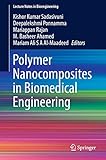Polymer Nanocomposites in Biomedical Engineering [electronic resource] / edited by Kishor Kumar Sadasivuni, Deepalekshmi Ponnamma, Mariappan Rajan, Basheer Ahmed, Mariam Ali S A Al-Maadeed.
Contributor(s): Sadasivuni, Kishor Kumar [editor.] | Ponnamma, Deepalekshmi [editor.]
| Ponnamma, Deepalekshmi [editor.] | Rajan, Mariappan [editor.]
| Rajan, Mariappan [editor.] | Ahmed, Basheer [editor.]
| Ahmed, Basheer [editor.] | Al-Maadeed, Mariam Ali S A [editor.]
| Al-Maadeed, Mariam Ali S A [editor.] | SpringerLink (Online service)
| SpringerLink (Online service) .
.
Material type:  BookSeries: Lecture Notes in Bioengineering: Publisher: Cham : Springer International Publishing : Imprint: Springer, 2019Edition: 1st ed. 2019.Description: X, 409 p. online resource.Content type: text Media type: computer Carrier type: online resourceISBN: 9783030047412.Subject(s): Biomedical engineering
BookSeries: Lecture Notes in Bioengineering: Publisher: Cham : Springer International Publishing : Imprint: Springer, 2019Edition: 1st ed. 2019.Description: X, 409 p. online resource.Content type: text Media type: computer Carrier type: online resourceISBN: 9783030047412.Subject(s): Biomedical engineeringThis book presents a thorough discussion of the physics, biology, chemistry and medicinal science behind a new and important area of materials science and engineering: polymer nanocomposites. The tremendous opportunities of polymer nanocomposites in the biomedical field arise from their multitude of applications and their ability to satisfy the vastly different functional requirements for each of these applications. In the biomedical field, a polymer nanocomposite system must meet certain design and functional criteria, including biocompatibility, biodegradability, mechanical properties, and, in some cases, aesthetic demands. The content of this book builds on what has been learnt in elementary courses about synthesising polymers, different nanoparticles, polymer composites, biomedical requirements, uses of polymer nanocomposites in medicine as well as medical devices and the major mechanisms involved during each application. The impact of hybrid nanofillers and synergistic composite mixtures which are used extensively or show promising outcomes in the biomedical field are also discussed. These novel materials vary from inorganic/ceramic-reinforced nanocomposites for mechanical property improvement to peptide-based nanomaterials, with the chemistry designed to render the entire material biocompatible. .


There are no comments for this item.